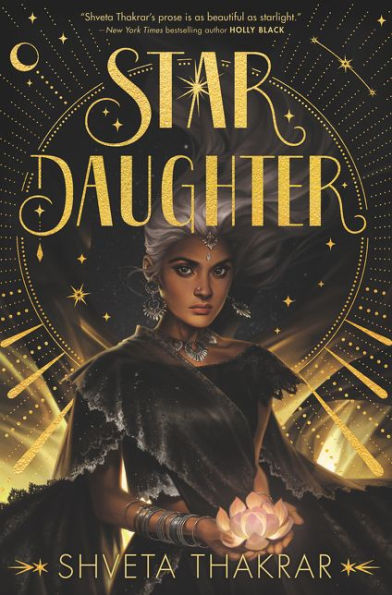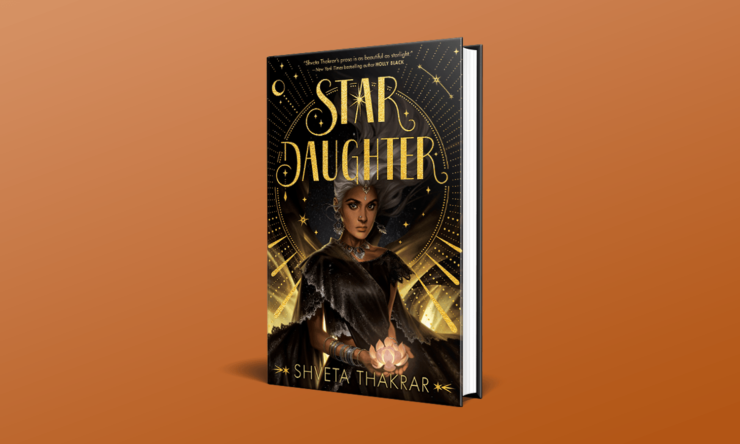Even though her mother is a star, Sheetal has always known an ordinary life on earth. After her mother Charamuti returned to the heavens leaving Sheetal behind with her father, Sheetal has tried not to draw attention to herself. But black hair dye can’t cover up her silver locks, and avoiding the spotlight hasn’t diminished her ability and talent to sing and hear the starsong, the celestial music in her core.
When it nears Sheetal’s 17th birthday, the call of the starsong grows too strong, and after a brush with her awakening powers, Sheetal heads to the heavens to reunite with her mother. But upon arrival to the Celestial Court, Sheetal is roped into a competition, one where mortals compete for their selected nakshatras, or houses, for a chance to win divine inspiration and fame back on Earth. Will being half-star risk her chances of winning? And is it enough to survive the Court?
Buy the Book


Star Daughter
Thakrar’s debut novel is a wonderfully woven YA fantasy tale that spins family history, Hindu cosmology and mythology, and the drama of a reality competition together. Thakrar gives readers a relatable protagonist in Sheetal in that she is searching for the freedom to embrace her identity. She knows she is special but is urged by her aunt and her father to tone down and seem average for her safety. Yet, her inability and, to be honest, the lack of guidance to control her magic causes Sheetal to accidentally injure her father, putting his life at risk. At the same time when Sheetal arrives in Svargaloka, she’s not 100 percent onboard with what her mother and grandparents have set up for her. Rather, she’s a little bit skeptical of her family’s motives, but also yearning to be a part of them. Even her mission to acquire full star blood to save her father’s life puts Sheetal’s loyalty in question.
On the surface Sheetal is welcomed, but the Celestial Court isn’t exactly home, and Sheetal grapples with the risks of choosing one home or the other. Sheetal’s relationships with her parents is core to the story, with her journey to the heavens fulfilling both of her needs—building a relationship with her mother and rescuing her father. I appreciate that Sheetal is not shallow enough to get swept up in the glamour of the stars, although being with her mother is what she’s dreamed of. Her father keeps her grounded, as Sheetal considers how to return home and if competing is the best way to save him.
Mythology can be considered history, and Thakrar uses that concept to her advantage by making the stories of the nakshatras and other deities part of Sheetal’s family history. The stories Charamuti had told a younger Sheetal were to give her daughter a familiarity and awareness of her Pushya nakshatra heritage, while also letting Sheetal know where she fits into humanity as a half-star. But Sheetal also learns about her history through other sources, like the shared dream with Dev, where she learns that his lineage birthed star hunters, and other people at the Celestial Court. It is through these secondhand discoveries and omissions that Sheetal gets further into the dark heart of her star family’s history and must decide as to how she wants to continue the Pushya star legacy. The stars are heralded as being divine and providing inspiration for humanity—but do they know what’s best for humanity? Thakrar manages to tie all these various histories together to create one complicated family history that honors both of Sheetal’s cultures.
The personification of the stars and their ability to grant inspiration to mortals is a fantastic concept that the author uses to explore the best and worst of humanity. Any creator always appreciates the burst of inspiration and clarity that comes about when creating their work. Yet the author manages to show the ugly side of inspiration as well, how this power from the stars can lead to unscrupulous choices out of desperation.
Thakrar takes readers from mundane Edison, New Jersey to glamorous and alluring Svargaloka, where Sheetal finds herself at the Celestial Court. Thakrar paints a picture of a stunning, vibrant heaven filled with various deities and creatures, awesome power, and enthralling magic. Svargaloka and the nakshatras are the enchanting homes of the stars, and also part of Sheetal’s heritage. The radiance of everything, from the food to the décor and the company is amplified to drive home the magic half of this other side of Sheetal’s family. Even The Night Market, the precursor to Sheetal’s journey, is an awe-inspiring, physics-defying place that sounds like an amazing place to visit. Thakrar’s prose and emphasis on detail really brings the universe to life, making it seem like a gilded celestial dream. The heavens and their inhabitants are not perfect by any means, but they are a source of beauty and hope for Sheetal and company. Additionally, the Hindu myths and beings that Thakrar draws upon are a great introduction for fantasy readers unfamiliar with South East Asian/Indian folklore and culture.
Star Daughter is a fantastic read about a young woman finding her footing between the worlds she inhabits and the magic of both those worlds.
Star Daughter is available from HarperTeen.
Read an excerpt here.
Gabriella Tutino is a NYC-based freelance court reporter, writer and book reviewer. Her work appears on Tor.com, Comics MNT, the US Review of Books, and Highbrow Magazine. Her favorite topics are mythology, anime, and fashion. You can find her travel blog here and follow her on Twitter @gabriellatutino.










